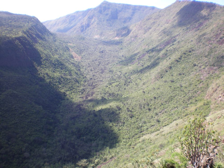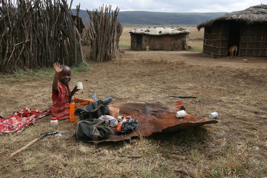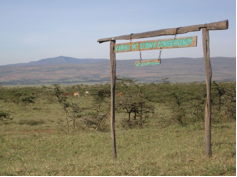

Mt. Suswa, between Naivasha and Narok, is a stunning volcano with a large, about 12 km diameter outer crater and a plateau at around 1,900 m a.s.l.. There is a fantastic inner circular crater or "Graben" of about 5 km diameter. From the plateau one may climb to the 2350 m peak or visit some of the famous caves. There are also hot springs from which the Maasai take their water. From afar, Mt. Suswa looks like an ordinary mountain, but from near and especially at the plateau, the mountain unfolds its awesome gorgeousness.
Yet the "hidden beauty" is endangered by overuse of its natural resources. The Maasai find it more and more difficult to live in an equilibrium with nature. Demands on firewood, land for livestock and agriculture are taking their toll. Deforestation has started, but a great deal of wildlife, animal and plant species is still thriving well. A herd of giraffes grazes at the foot of Mt. Suswa together with zebras and Thomson gazelles. Millions of bats live in some of the 10 km long cave system. Leopards, baboons and other wildlife are abundant on the inaccessible inner crater called Olorika (the "Seat") by the Maasai.

Until some decades ago the Maasai used to live a nomadic life accompanying their livestock in the search of green pastures. Today, there are about 50 compound homes, with some 1,000 people altogether. Land is very scarce. There isn't enough land anymore to live from the livestock alone. Much land has therefore been turned into agriculture: maize and beans mainly. The people hesitate to reduce the livestock, as it is a sign of wealth and importance. This results in considerable overuse of the plateau consisting of grassland, shrubs and bushes. Women also collect firewood to prepare meals. Thus, even in this remote part of Kenya, natural resources are depleting fast, and firewood has become very scarce.
The Maasai have recognized that they need to shift to a use of their environment that is in harmony between growth and consumption of nature, and that trees need to be planted and protected against their own animals.

The Private Sector Development in Agriculture (PSDA) project, which is implemented by the the Ministry of Agriculture (MoA) and the German Technical Cooperation (GTZ), has recently started to assist the Maasai in introducing and popularizing energy saving stoves or jiko kisasa. These stoves use about 40% less firewood compared to the traditional three-stone fire place, and they produce much less smoke, which is a health threat in the small homes. More than 200 jikos have meanwhile been built on the Suswa plateau and around the volcano, and many more will follow.
The success story has rapidly spread throughout the country. The project has trained many artisans and supported the production and sale of stoves. More than 700,000 households all over Kenya are now proud owners and users of the energy saving stoves. The total of saved firewood is equivalent to an impressive area of 43.500 ha of primary forest that does not need to be cut down. Less energy also means less emissions of the detrimental green house gas carbon dioxide. Nearly 1.5 million tons are less emitted. This takes pressure from the environment and contributes to biodiversity and intact natural resources.

On the 15th of May, the Maasai community and school children will come together at the school on the plateau. Artisans of the 3 locations of firewood saving stoves will also attend. The community and the school children will first assemble and listen to speeches from the Chief, local elders and environmental experts. Representatives of PSDA will talk about the importance of firewood saving stoves in order to reduce the pressure on the forest and natural resources. The WWF and the Mt. Suswa Conservation Trust will speak about the importance of tree planting.
Subsequently, community members and school children will undertake nature walks to the near forests at the crater, parts of the cave system with bats and other interesting spots. They will come back and exchange their experiences and discuss the ecosystems services of the various animals, plants and physical features of the environment. Finally under the guidance of an expert of the WWF and the Mt. Suswa Conservation Trust trees will be planted around the school.
Photos: Antti Seelaff, Eberhard Krain
Back to report.